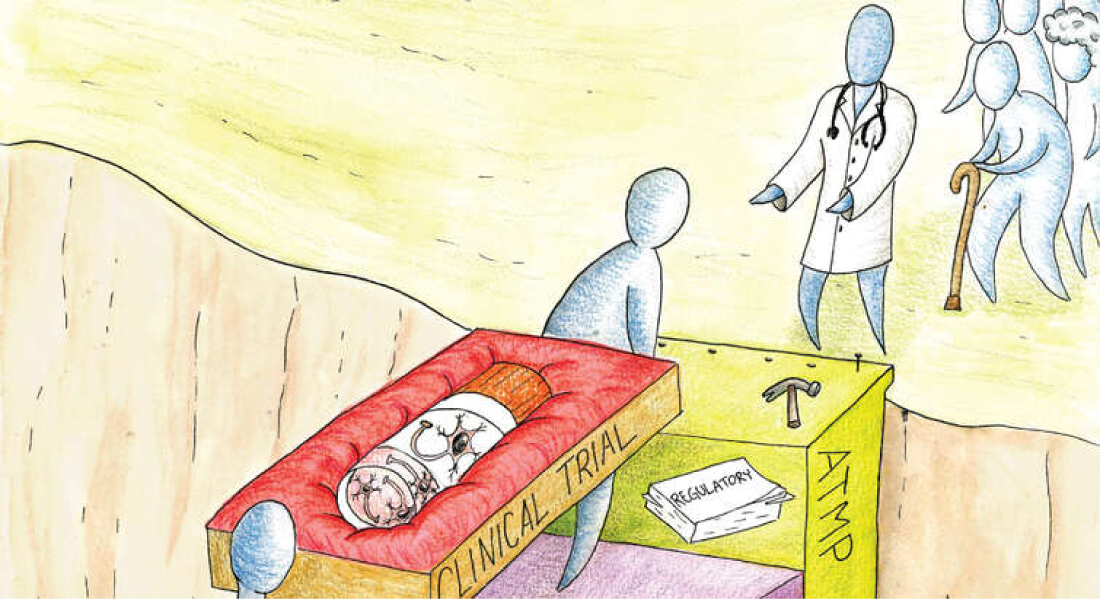Behind the scenes of a novel stem cell therapy for Parkinson’s Disease
Parkinson’s Disease is a neurodegenerative disease characterized by the loss of normal motor control, leading to rigidity, slow movements, tremor, and difficulties walking. The disease affects approximately 1% of the population above the age of 60 and with an aging population, its prevalence is increasing. Parkinson’s Disease involves the loss of a particular type of nerve cell in the brain, namely the dopamine-producing nerve cells, located in a brain region called the substantia nigra. The loss of these nerve cells is what causes the severe motoric symptoms in patients.

Today, Parkinson’s is treated symptomatically with daily doses of medications, which, with time, lose efficacy and can cause severe side effects. A commonly administered medication for Parkinson’s Disease is levodopa, which is a dopamine replacement agent designed to increase the levels of dopamine in the brain. However, some researchers have proposed that instead of medications, the disease may be treatable through stem cell transplantation.
In October 2022, following 13 years of preparatory work, a novel stem cell transplantation product, STEM-PD, was approved by the Swedish regulatory authorities for a Phase I/IIa clinical trial in Parkinson’s Disease, and the first patient in this trial was dosed with stem cells in February 2023. This is the first time in Europe a stem cell therapy of this type is being tested in Parkinson’s Disease, representing a significant leap forward for the clinical implementation of stem cell therapies.
“This is an important step towards bringing stem cell therapies for Parkinson’s Disease to patients. Such therapies have the potential to reform the way we treat the disease,” says Associate Professor, Agnete Kirkeby, who led the preclinical development of the product.
The therapy involves creating new dopamine producing nerve cells from stem cells in the lab. These nerve cells are then injected into the brains of patients with Parkinson’s Disease. The hope is that these new cells will mature, integrate and function in a manner that is very similar to the endogenous nerve cells the patients have lost. As the transplanted nerve cells are expected to produce dopamine directly within the brain, symptoms of the disease may reduce without the need for daily dopamine medications.
“If the therapy works, we hope to see that the patients with time will reduce their dopaminergic medication, and that they will regain some motor function in the absence of medication,” says Dr. Kirkeby.
Now, the group behind the development of the stem cell product has released a behind-the-scenes article describing the in vitro and in vivo tests conducted on the product to achieve regulatory approval for transplantation to the first patients. In the case of trials conducted by pharmaceutical companies, such data is often hidden from the public, however, for the STEM-PD researchers, it was important that their data was made publicly available.
“Releasing such data provides an unusual window into the comprehensive and rigorous testing needed to bring novel stem cell therapies into clinical trial. This is highly valuable information for other scientists in the field and may hopefully help to speed up clinical development of stem cell therapies also for other diseases,” says Dr. Kirkeby.
The product has been developed with Professor Malin Parmar at Lund University in Sweden. where Agnete Kirkeby is also affiliated, and in collaboration with neurologists and neurosurgeons from University of Cambridge and Skåne University Hospital. The team has further partnered with the pharmaceutical company Novo Nordisk A/S for clinical trial support and further product development. Two other groups in the world, one in Japan and one in the USA and Canada, have also initiated trials with similar types of products, but STEM-PD is the first European-based product to reach clinical trial.
If the outcome of this initial academic clinical trial demonstrates safety of the treatment after 12 months, research partner Novo Nordisk A/S is planning to conduct further trials and product development, with the potential of bringing the STEM-PD product to the market.
The full paper for the preclinical work on STEM-PD was published on October 5th 2023 in the journal Cell Stem Cell and is entitled: “Preclinical Quality, Safety and Efficacy of a Human Embryonic Stem Cell Derived Product for the Treatment of Parkinson's Disease, STEM-PD”.
More information on the STEM-PD trial and STEM-PD team can be found here:
- www.stem-pd.org
- https://www.lunduniversity.lu.se/article/first-patient-receives-milestone-stem-cell-based-transplant-parkinsons-disease
- https://www.lunduniversity.lu.se/article/nerve-cells-could-transform-treatment-parkinsons
Credits image: Katrine Bech Lauritzen
